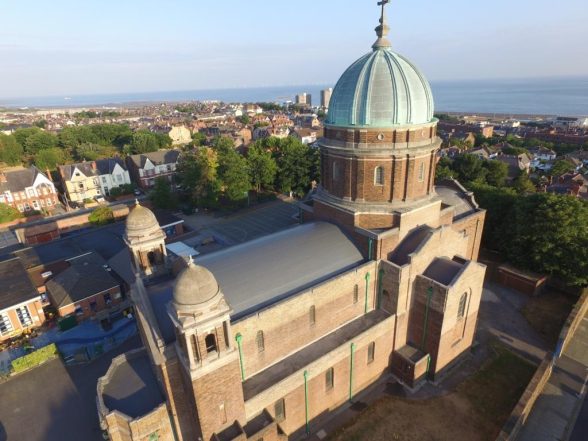This website uses cookies
This website uses cookies to enable it to function properly and to analyse how the website is used. Please click 'Close' to accept and continue using the website.



Image: Historic England
A landmark church on the Wirral peninsular and former C20 Building of the Month has been removed from Historic England’s ‘Heritage at Risk’ register, following a spirited local campaign backed by the Society and a decade long restoration project.
The Catholic Church of Ss Peter, Paul and St Philomena in New Brighton was built in 1935 to designs by E. Bower Norris of Sandy and Norris architects. The church’s soaring brick-encapsulated concrete frame and copper dome is recorded on marine navigation chart and has signposted the entrance to the River Mersey for nearly 90 years. During the Second World War, returning sailors would seek out the distinctive form of the ‘Dome of Home’, a sign they had survived the perils of the Atlantic. The church was Grade II listed in 2003.
In 2007 parishioners were distressed to hear that the Bishop of Shrewsbury had decided to close the church and merge the remaining congregation with that of a neighbouring Church of England parish. As well as citing a declining attendance at Mass, the church had suffered from decades of water penetration with repair costs deemed to be prohibitively expensive. At the time Merseyside was experiencing a property boom and The Diocese held exploratory meetings with developers regarding a demolition and redevelopment of the site.

Image: Ss Peter & Paul and St. Philomena
A local campaign group called SOUL – Save Our Unique Landmark – was set up to oppose closure and attracted strong support from local people, politicians and C20. The group undertook small repairs to maintain the building themselves, despite the initial reluctance of the Diocese. However, their protests were in vain and the church closed in August 2008; it was added to Historic England’s national ‘Heritage at Risk’ register shortly after. SOUL appealed through the Catholic canon legal system to the Vatican and in August 2009 Archbishop Piacenzo of the Congregation of Clergy ruled that the closure broke canon law and that it was ‘null and void’.
A dedicated team from the church and the local community, led by Institute of Christ the King clergy who care for the church, then galvanised action throughout five phases of restoration work over nine years to bring about a painstaking restoration, leading to its recent removal from the At Risk Register.
The first phase began in 2013 to address the most severely affected area damaged by water ingress, including conservation work to the concrete frame threatening the survival of the entire structure, window restoration, re-pointing the brickwork, re-roofing and insulation. This was closely followed by Projects Two (2014) and Three (2016) focussing on different high-level areas of this majestic church. Project Four (2018-2021) was a larger challenge, because it involved the concrete restoration of the Dome, Drum and main Sanctuary roof.

Image: Historic England
During final delivery of this project, further works took advantage of the internal scaffolding to transform the interior with new lighting and decoration schemes, centred on the revival of the elegant interior, where a concrete vaulted frame once again encloses an impressive worship space. The extensive works were led by conservation architects Lloyd & Smith and funded by private donors and organisations including: the National Lottery Heritage Fund, National Churches Trust, AllChurches Trust, Historic Cheshire Churches Preservation Trust, Wallasey Bright Ideas Fund, Love Wirral, The Latin Mass Society, Listed Places of Worship Grant Scheme and the Duchy of Lancaster Benevolent Fund.
Canon Amaury Montjean commented: “So many people from the local community have been involved in restoring both this amazing building and its spiritual purpose. Together with the expertise and funding provided by so many people and organisations, their belief and determination mean that the Dome of Home will continue to be a much-loved landmark and focal point for the community for many years to come.”

Become a C20 member today and help save our modern design heritage.